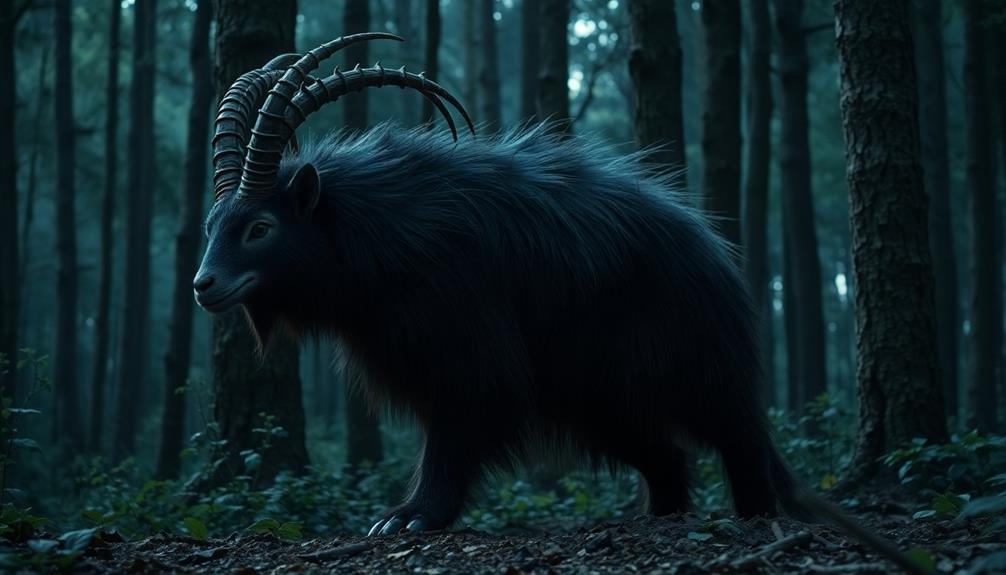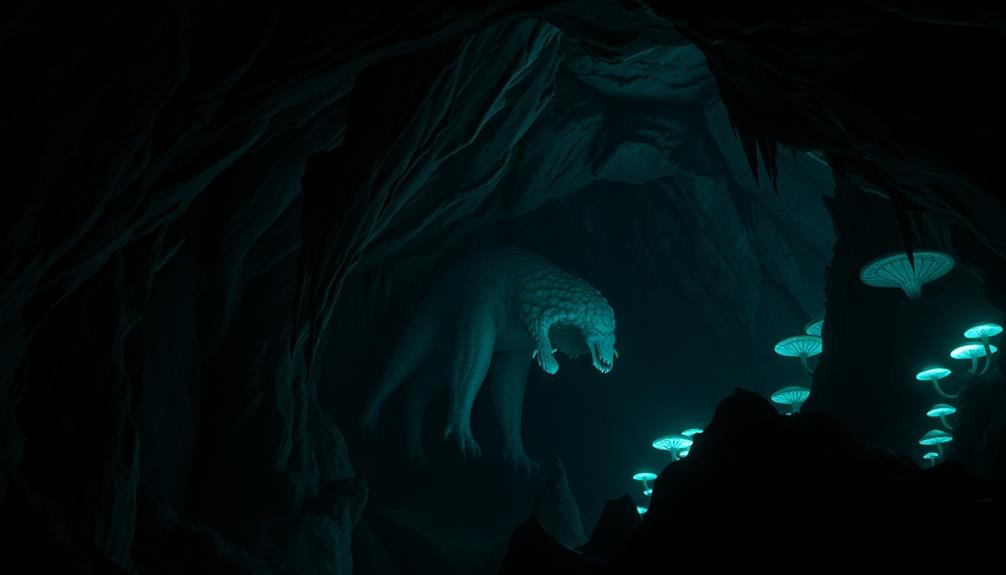If Chupacabra's appearance changes based on what it hunts, you'd see a creature finely tuned to its environment. In regions with livestock, it might adopt a more robust, bipedal form with spines to tackle goats. In contrast, in areas where it preys on smaller animals, like chickens, it could appear smaller and hairless, resembling a mangy dog. These adaptations suggest that its hunting strategy is influenced by the size and type of prey available. As you explore further, you'll uncover more intriguing aspects of the Chupacabra legend and how it continues to evolve in the public imagination.
Key Takeaways
- Chupacabra's appearance varies regionally, adapting to local prey such as goats in Puerto Rico or chickens in the U.S.
- Bipedal forms in Puerto Rico suggest agility for targeting larger livestock, while smaller quadrupedal forms are suited for scavenging.
- Physical traits like spines may evolve based on hunting challenges and prey size, reflecting adaptability in hunting strategies.
- Eyewitness descriptions can be influenced by media portrayals, distorting perceptions of the creature's appearance based on its hunting preferences.
- The creature's evolving mythology illustrates how environmental factors and prey availability shape its physical characteristics over time.
Chupacabra Origins and Background
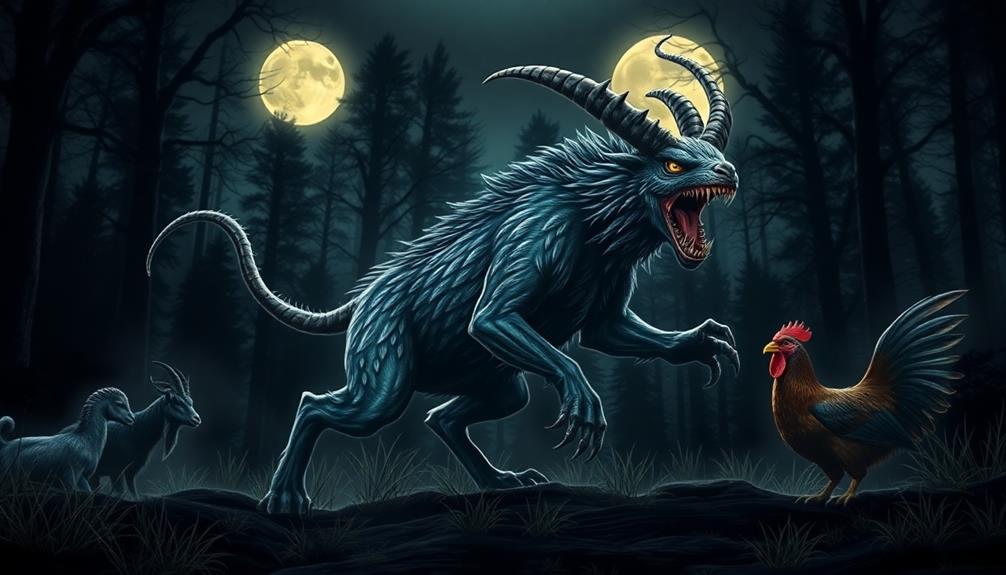
The chupacabra, which means "goat sucker" in Spanish, originated in Puerto Rico in March 1995. This mysterious creature quickly became infamous due to a series of livestock attacks marked by blood-drained bodies.
Eyewitness accounts of the chupacabra vary widely. Some describe it as a bipedal creature with spikes along its back, while others depict it as dog-like or even reptilian.
The legend gained traction as media coverage spread reports of sightings, creating a cultural phenomenon that captivated people across Latin America and beyond. Farmers in Puerto Rico were particularly affected, losing goats and chickens to these strange attacks.
The chupacabra's association with livestock led to widespread fear among those who relied on their animals for sustenance.
Interestingly, the scientific community often attributes chupacabra sightings to misidentified animals, specifically coyotes suffering from sarcoptic mange. This condition alters their appearance, causing them to look emaciated and unusual, which might explain some of the reported sightings.
The Myth of the Chupacabra
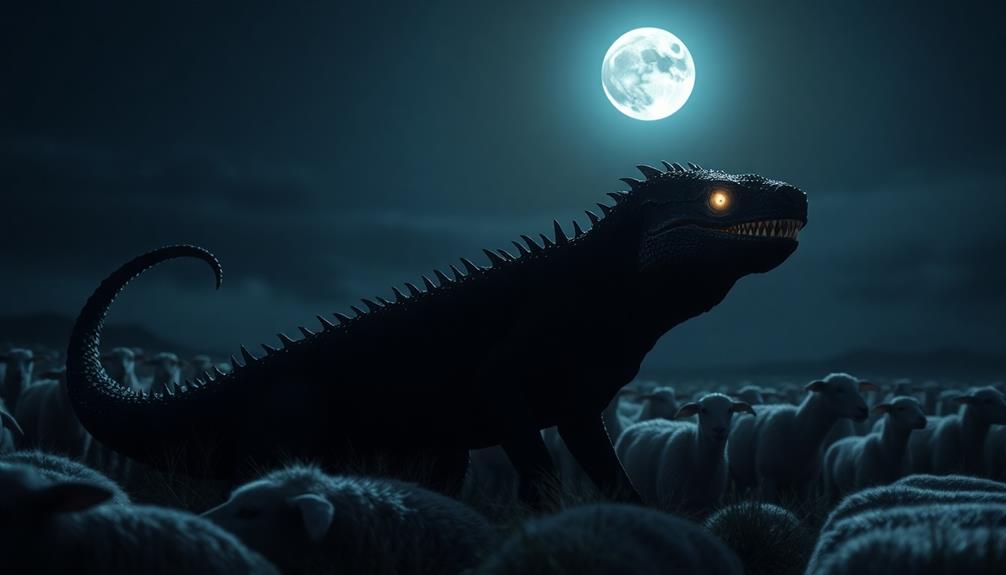
Chupacabra myths have woven themselves into the fabric of folklore, enthralling imaginations with tales of a bloodthirsty creature lurking in the shadows. The legend of the chupacabra dates back to 1995 in Puerto Rico, where reports emerged of livestock—especially goats—found drained of blood. These eerie accounts painted a picture of a creature with red eyes, striking fear into the hearts of farmers.
Witnesses described it in various ways, often as a reptilian or canine figure, which raises intriguing questions about its appearance. Some believe that the chupacabra adapts its look based on its prey, explaining the differences in descriptions. Eyewitnesses noted spines or spikes along its back, suggesting adaptations for attacking livestock.
While many sightings fueled the myth, scientific investigations typically linked these creatures to misidentified animals, like coyotes suffering from mange. This casts doubt on their existence as a distinct species, instead hinting that the creature's appearance may vary with the condition of the animals it mimics.
As the chupacabra continues to capture public interest, its myth evolves, reflecting local folklore and the fears surrounding livestock predation.
Variations in Chupacabra Descriptions

When you look at Chupacabra descriptions, you'll notice they vary widely based on hunting preferences and regional influences.
Some sightings paint it as a reptilian creature, while others depict a mangy dog-like beast.
These differences raise questions about how these creatures might adapt over time to their environments and prey.
Hunting Preferences and Appearance
Variations in chupacabra descriptions often reflect their hunting preferences, showcasing how these creatures adapt to their environments and prey. For instance, in Puerto Rico, the chupacabra is frequently described as a bipedal entity with spikes, linked to attacks on goats. This vampiric portrayal emphasizes its aggressive hunting style and the need for a formidable appearance to tackle larger prey.
Conversely, sightings in the U.S. depict the chupacabra as a smaller, hairless quadruped, typically associated with attacks on chickens or rabbits. This shift in appearance suggests that the chupacabra's form is influenced by the size and nature of its prey, tailoring its hunting strategies accordingly.
Additionally, eyewitness accounts are often swayed by media portrayals, which can further distort perceptions of the chupacabra's appearance based on the livestock involved.
The physical traits attributed to the chupacabra, like spines or leathery skin, may serve as adaptations to overcome specific hunting challenges, particularly when pursuing elusive prey.
Regional Variations in Descriptions
Descriptions of the chupacabra differ widely across regions, reflecting local culture and folklore. When you hear about the creature for the first time, you might picture the classic image from Puerto Rico, where witnesses often describe it as having lizard-like features and spines, reminiscent of alien creatures from films like "Species."
In contrast, U.S. sightings typically depict it as a small, hairless quadruped with grey skin, sometimes resembling mangy coyotes.
The physical appearance of the chupacabra varies considerably. Some reports describe a bipedal creature standing 4-5 feet tall, while others evoke images of a dog suffering from severe mange.
These regional differences highlight how local fears and concerns shape interpretations. For example, those hunting livestock or pets might describe the creature with bug-eyed features and sharp claws—attributes that reflect the perceived threat it poses.
Ultimately, the chupacabra serves as a canvas for cultural anxieties, adapting its image based on the environment and the prey it targets.
Evolutionary Adaptations Over Time
The chupacabra's evolving appearance can be seen as a reflection of its adaptability to local environments and prey types. Descriptions vary considerably, with the original Puerto Rican sightings depicting it as a lizard-like creature with green-gray-black scales. This may indicate evolutionary adaptations to hunting livestock like goats and chickens.
In contrast, U.S. reports often describe the American chupacabra as a smaller, quadrupedal creature with grey, hairless skin, likely representing adaptations for hunting smaller animals or scavenging.
Scientists say these variations illustrate how the chupacabra myth evolves alongside local fauna and environmental conditions. The physical traits of these creatures mightn't be entirely mythical; analyses of alleged chupacabra remains often reveal a canid lineage.
Many of these canids, such as coyotes with mange, exhibit features that closely resemble the chupacabra descriptions. This suggests that sightings could stem from encounters with affected wildlife rather than a distinct creature.
As prey availability shifts and ecosystems change, the chupacabra's appearance likely adapts, demonstrating the creature's perceived ability to thrive in various contexts while feeding on different prey.
Scientific Explanations for Sightings
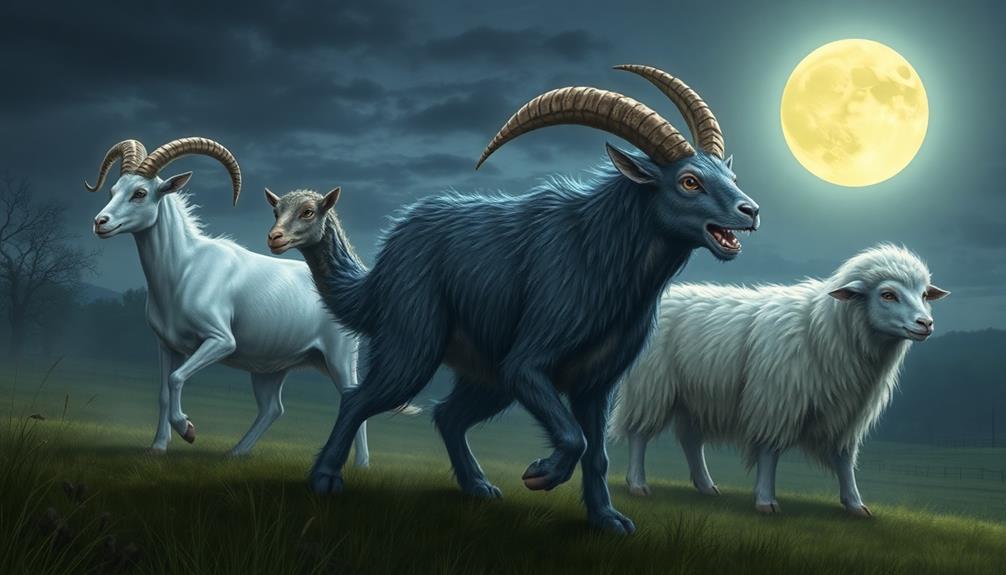
When you look closely at chupacabra sightings, you'll find that many reported cases stem from misidentifying wildlife, especially coyotes affected by mange.
These animals can appear quite monstrous due to their hair loss, leading to exaggerated descriptions.
Additionally, environmental factors can influence how these creatures behave, further complicating eyewitness accounts.
Misidentification of Wildlife
Many chupacabra sightings can actually be traced back to misidentified wildlife, particularly coyotes affected by sarcoptic mange. This condition leads to severe hair loss, causing these animals to develop a gaunt, skeletal appearance that can easily be mistaken for the mythical creature.
In regions like Minnesota, where abundant wild edibles can be found, the presence of coyotes can be more common as they search for food. When you hear eyewitness descriptions of chupacabras, you'll often find they closely match the look of these unfortunate coyotes.
In fact, a 2004 investigation in Texas revealed that livestock carcasses initially thought to be the work of chupacabras were later identified as coyotes suffering from mange. DNA evidence further supports this idea, showing that many supposed chupacabra specimens are simply domestic dogs or canids with severe cases of mange.
The lack of solid physical evidence for chupacabras, combined with the prevalence of misidentification of wildlife, suggests that many sightings are exaggerated interpretations of common animals.
Impact of Environmental Factors
Environmental factors play an essential role in shaping the appearance and behavior of wildlife, which in turn influences chupacabra sightings. When habitat loss and food scarcity occur, coyotes may suffer from mange, distorting their typical appearance. These afflicted animals can resemble the mythical chupacabra, leading to misidentifications.
| Environmental Factor | Effect on Wildlife |
|---|---|
| Habitat Loss | Increased competition for food |
| Food Scarcity | Health issues in coyotes and dogs |
| Mange | Distorted appearances |
| Presence of Livestock | Unusual hunting tactics |
| High Canid Populations | More chupacabra reports |
In areas with high livestock populations, you might notice odd behaviors from local predators. The presence of goats or chickens can drive coyotes to hunt differently, intensifying the likelihood of misidentification. Reports of blood-drained livestock often align with regions experiencing a surge of mangy canids. Scientific investigations reveal that many alleged chupacabra remains are actually domestic dogs or coyotes suffering from health issues. By understanding these environmental factors, you can better discern the truth behind chupacabra sightings and their connection to local wildlife dynamics.
Cultural Impact and Media Representation
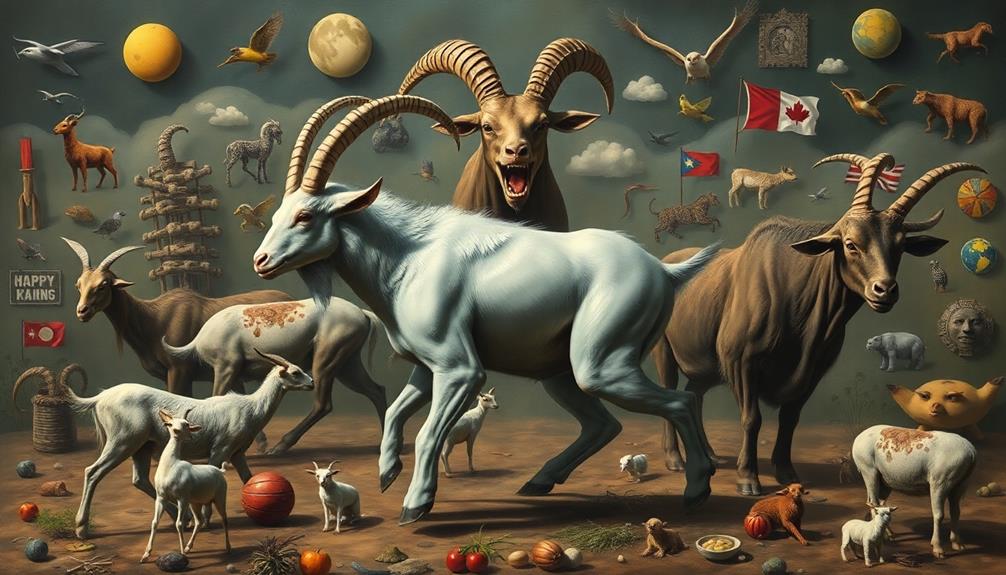
The Chupacabra has undeniably carved out a significant niche in popular culture, influencing everything from television shows to local folklore. Its depiction as a fearsome, blood-sucking creature emphasizes alien-like features and reptilian traits, reflecting cultural anxieties and collective fears. Shows like "The X-Files" and "South Park" have elevated the Chupacabra's status as a horror symbol, blending myth with entertainment and ensuring its place in the cryptid lexicon.
Eyewitness accounts, often amplified by the media's sensationalization, contribute to varied descriptions of the Chupacabra across regions. Popular films like "Species" have shaped public perception, leading to a mix of terror and intrigue surrounding the creature. These cultural interpretations have resulted in merchandise and local legends, underscoring the Chupacabra's role in community identity and folklore.
Moreover, the media's relentless focus on Chupacabra sightings often overshadows scientific perspectives, fueling ongoing discussions about cryptids. As you engage with these narratives, consider how they reflect broader societal themes and anxieties, turning a creature of folklore into a symbol that resonates with your own cultural experiences.
Chupacabra in Popular Culture
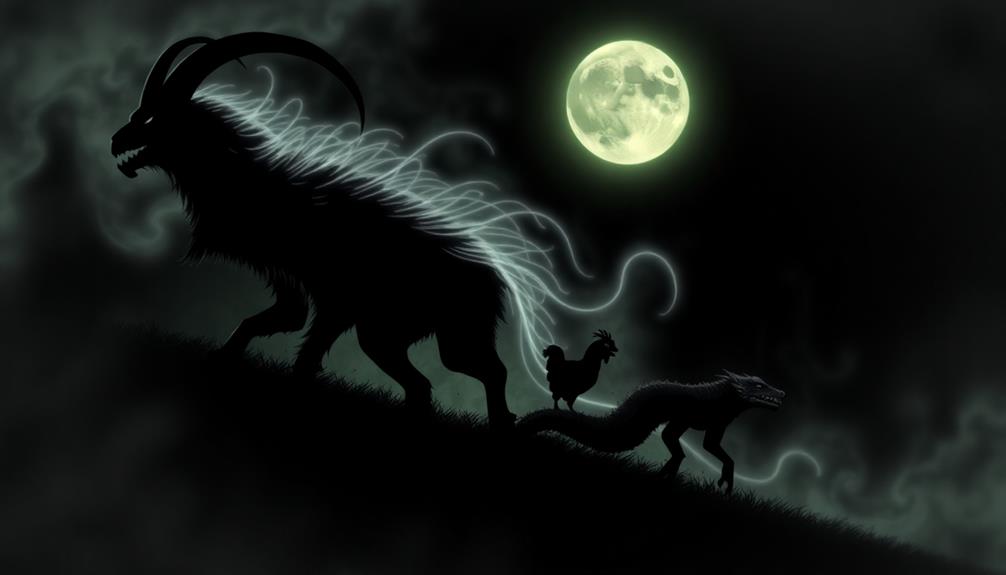
Popular culture has embraced the Chupacabra, transforming it from a local legend into a widely recognized figure. This blood-sucking creature, often referred to as El Chupacabra, has appeared in various media, enthralling audiences with its horror and mystery. Television shows like "The X-Files" and "Grimm" highlight its terrifying aspects, while animated series such as "South Park" take a humorous approach, showcasing the creature's versatility in popular culture.
The Chupacabra's cultural significance extends beyond TV, inspiring songs like "Chupacabra" by the Randy Rogers Band and La Maquinaria. These musical interpretations reflect the creature's integration into contemporary narratives.
Eyewitness accounts also reveal the influence of media on public perception, with films like "Species" shaping how people visualize El Chupacabra.
As it permeates various forms of entertainment, the Chupacabra has become a symbol of fear and intrigue, influencing local legends and community stories across Latin America and the U.S. Its evolution in popular culture illustrates how folklore can adapt, maintaining relevance while engaging new audiences.
The Chupacabra's journey from myth to icon shows the power of storytelling in shaping our understanding of the mysterious.
Adaptability and Hunting Strategies
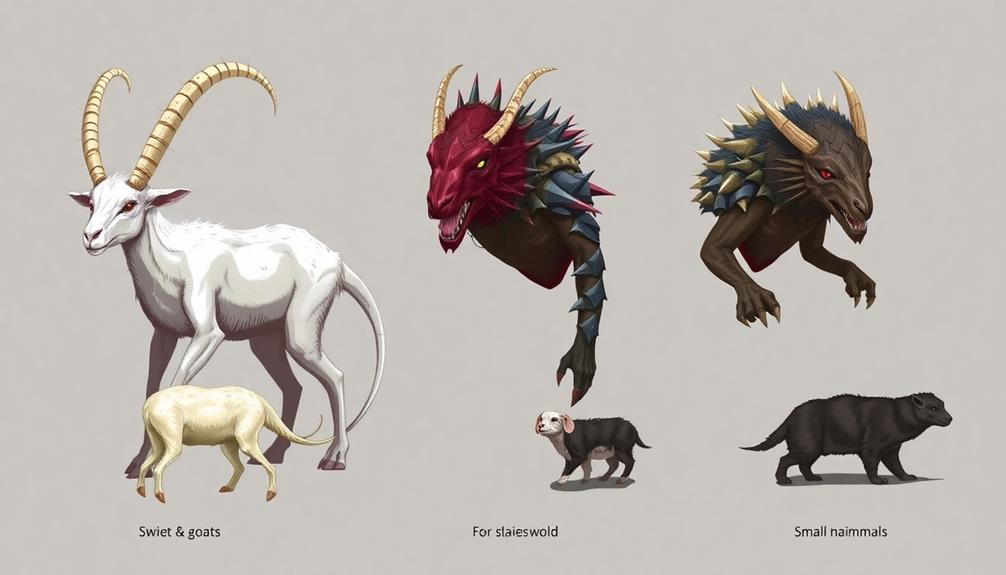
Frequently, the Chupacabra's adaptability is highlighted in reports of its varied appearances and hunting strategies. This creature seems to morph based on its prey, displaying features that enhance its hunting efficiency. For instance, you might notice that a bipedal creature form is more agile for targeting smaller animals, while a sturdier physique is better suited for larger livestock.
The table below illustrates some of these adaptations:
| Prey Type | Adaptability Features |
|---|---|
| Goats | Robust body, sharp claws |
| Chickens | Agile limbs, stealthy movement |
| Small rodents | Quick reflexes, low profile |
| Larger animals | Powerful build, strategic hunting |
Reports often describe variations in size and shape. Some sightings resemble dog-like or rodent-like creatures, leading to confusion with misidentified coyotes. This highlights how the physical state of an animal can influence its perceived form. The Chupacabra's ability to switch between hunting strategies allows it to effectively target a range of livestock, showcasing a fascinating evolution in response to hunting demands.
The Future of Chupacabra Mythology

As you explore the evolving narrative of the Chupacabra, it's clear that its mythology has transformed considerably since the 1990s. What began as a chilling Chupacabra mystery has grown into a multifaceted legend, shaped by cultural retellings that reflect local fears and environmental contexts.
You might notice that the Chupacabra's appearance varies widely—from reptilian creatures in some regions to more canine-like beings in others—each version tailored to the specific fauna it's believed to hunt.
In today's media, the Chupacabra is often portrayed with a newfound sympathy, as seen in family-friendly adaptations like the film "Chupa." This shift signifies a broader cultural trend where the creature evolves into a metaphor for our struggles with habitat loss and ecological imbalance.
As we look to the future, expect ongoing reinterpretations of this new legend that merge folklore with contemporary issues. The Chupacabra could serve as a symbol of the human connection to the unknown in wildlife and our responsibility toward the environment.
Ultimately, the mythology will likely continue to adapt, reflecting our changing relationship with nature and the mysteries it holds.
Conclusion
In the end, the elusive chupacabra captivates curiosity and challenges conventional concepts of creatures. Its shifting shape showcases a stunning symbiosis with its surroundings, adapting to hunt and survive. This mysterious monster melds myth and reality, merging folklore with fascination. As you ponder its potential, remember that the chupacabra's story continues to evolve, enchanting enthusiasts and sparking speculation. The future of this fabulous fiend lies in the imagination, forever flitting between fact and fiction.

